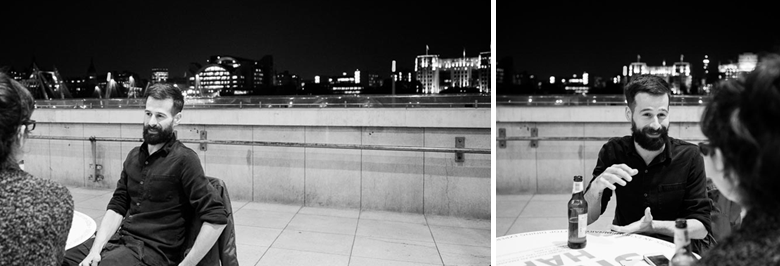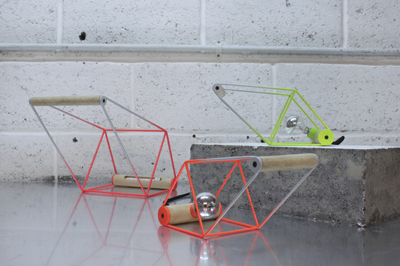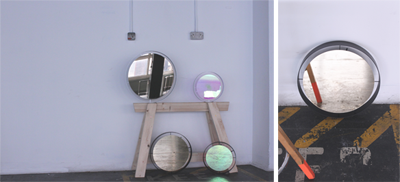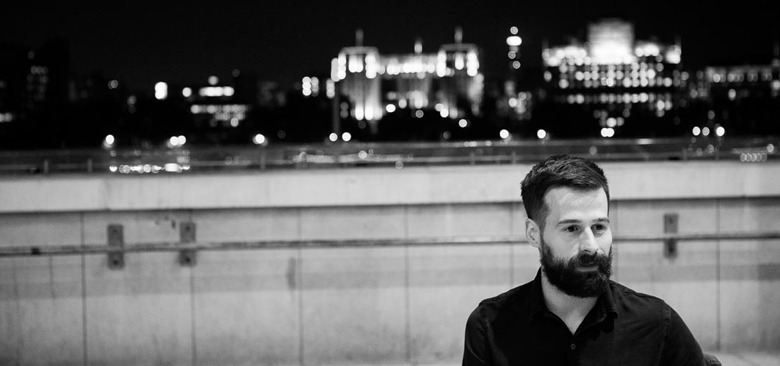When you think about the Koldo Camacho’s story, you have to imagine a path that was always leading towards design. A native of Donosti-San Sebastian, his work has led him to live and work in Madrid, the south of France and London; he has put on exhibitions in Milan’s design show and, more recently, at London Design week.
When you think about the Koldo Camacho’s story, you have to imagine a path that was always leading towards design. A native of Donosti-San Sebastian, his work has led him to live and work in Madrid, the south of France and London; he has put on exhibitions in Milan’s design show and, more recently, at London Design week.
When you design something, you produce the work on paper or in a 3D-modelling program, but it is not a physical object. By contrast, now I am doing exactly that: I start with nothing, with sheets of metal or planks of wood and everything is done by hand. I cut by hand, build it and when I finish a piece of furniture I feel very proud. I like that whole process: designing it, being able to build it with my own hands and finally seeing it finished.
His travels take us on a non-traditional journey, but his character runs through it like a stick of rock. His style plays with raw materials like metal, wood, light and salt; all personally handcrafted.
Although wrought by an artisan, Camacho’s work is modern, along simple lines. It includes ideas on the materiality of the objects he creates, such as the clock-mirror Partial. The completion of his pieces reflects the importance of creating quality objects that stand the test of time, using high-end materials.
He has a clear idea of what he is looking for and he has taken a moment to chat with Brit Es in the Royal Festival Hall to tell us about the evolution of his work, how he started his search and where he is now.

Interview Images © Noela Roibás
What was your education like?
I’m a welder. At 22, I was working in a factory and it was not what I liked doing. At that time, in Donosti they were offering a photography course that was part of the preparatory stage of applying for studies in design. From that point on, I studied interior design. Because of my interest in scenography I wanted to study something more in order to fill out my education, but by this point in life, it was already very late to think about reading for a full degree.
I went off to Madrid to study Temporary Architecture, which is related to designing stands and sets. I like architecture, but I do not see myself building something that will take up five years of my life. I like interior design because it’s quicker and you see results much sooner, in five months, it’s job done. It was there that I began to be interested by furniture, and how it’s made.
In Madrid I was working for a cutting-edge firm in the field of exhibition design, with clients like the Prado and Thyssen museums. On the one hand, it was very rewarding, because you are dealing with works of art, creating the space that will house those paintings. But at the same time, it’s a little frustrating, because you are not able to really design as much. The important thing there is the artwork, so you have to look for a balance.
Now in London you work in Matt Stanwix’s studio, how are you finding it?
It is a workshop, and what we do is manufacture furniture, which is the part that I like. I design practically nothing, they give me everything almost completely finished, but I enjoy the process of making it.
When you design something, you produce the work on paper or in a 3D-modelling program, but it is not a physical object. By contrast, now I am doing exactly that: I start with nothing, with sheets of metal or planks of wood and everything is done by hand. I cut by hand, build it and when I finish a piece of furniture I feel very proud. I like that whole process: designing it, being able to build it with my own hands and finally seeing it finished.
When it comes to furniture, is your vision more aesthetic or functional?
Where I am currently working, it’s more aesthetic; the furniture is commissioned and has little functional use. Even if it is not to my taste, it has been a very good learning environment. In the future I want to have my own workshop and I would like to work on limited runs, not mass production.
In that sense, functionality versus aesthetic, I tend more towards the artisan side which combines the aesthetic vision with the quality of the material, some values that I think are being lost. I come from a family in which my grandfather used to make incredible model boats and he was a painter too; my father is also good with his hands and that is what I like. Artisan work done by hand. I know that it’s more difficult, and I hope to design something that sells millions of copies, but it is not really what I’m after.

Flag Collection by Koldo Camacho
Which material do you feel most comfortable working with?
At the moment, metal above everything else, more than anything because in the workshop I have the tools to be able to manipulate it and then it would be wood. But I have got another project too, in which I want to work with salt, I am investigating how to go about creating a texture with salt.
I am obsessed with lighthouses: they are linked to the sea, salt and illumination. It is a concept that I want to develop and present at the next show in Milan. I am always experimenting with different materials and how they are affected by corrosion or acid, for example. I am at the stage of experimenting, investigating and seeing what happens from there.
How did you get to London Design Week?
In April of this year I was in Milan presenting the project Flag Connection with an organization called Ventura Lambrate, who also organised the first version of the show here in London. I put myself forward, paid for the stand and presented the project. Over the course of the show, all the big, household names are here and the Ventura Lambrate stand was an area dedicated to young designers with fewer resources and, for that reason, you see really interesting things, because these designers have the freedom to do whatever they like.
Participating in these shows was something very personal. I do not know how much longer I will be in London and when I come back I want to feel that I have done something of substance. I was at Design Junction, on New Oxford Street exhibiting Partial, which was very well received.
The two shows have been excellent experiences. It is the other side of being a designer, the logistics part of setting aside time to promote yourself and sell your products. You can have something amazing, but if you do not know how to sell it, it just stays there and no-one knows anything about it, or you can get lucky and someone will see what you are doing and from there you go on to develop contacts with more people.
What I took from Milan is that I presented my own project, which people liked and I am staying with that idea. Recognition is great too, but I am very critical of myself. When you are presenting something and people like it, it gives you that feeling that what you are doing is not too bad. Partial by Koldo Camacho
What is your inspiration with respect to design?
I went on a trip to Barcelona when I was 19 and I visited the Barcelona Pavilion, by Mies van der Rohe, of the Bauhaus school. From then on, he was my point of reference. He is very rational, very linear; he creates spaces with nothing but visual planes. Then you go on taking things from different disciplines, various artists, but that building and the work of Mies van der Rohe really stayed with me. In fact, every time I go to Barcelona, I go and see it.
I also really like Turner’s paintings. It depends a bit on the project you are doing, you go along picking up ideas or references from your diary, or your files and you carry on creating.
And London is inspiring, the city inspires you; I will go out for a walk and I will always take notes. Last week, for example, I was at Somerset House in an illustration exhibition and you always take something away with you from what you find. That is what a big city can offer you in comparison with the little towns near San Sebastian with only 11,000 inhabitants, which is where I am from.
What are your short and long term projects?
Last Christmas I worked with a few guys from Madrid who are called Luzinterruptus and it was an awesome experience. I was in Durham, near Newcastle, making a Christmas tree with 3,000 illuminated plastic bags. I spent hours with people from Durham, young and old, and I loved it. You would go onto the streets and they would say hi and recognise their plastic bags!
It is something totally different to what I do and the whole experience with Luz interruptus is hugely interesting, so in November, I am going to collaborate with them again on the same project, this time in Stoke-on-Trent.
Long term, I would like to have my own workshop; being able to manufacture what I design is my dream. If it is not my own project, it takes a lot for me to work on it; working with a boss who tells you what to do and how to do it is not really for me.
I see design as a way to express yourself and that is what I am looking for: creating that object that you have got at home and you never want to chuck away. I do not want to create a table that you get tired of after two years and bin. I am reminded of my mother who has two ceramic dragons and she takes them everywhere. To be honest, I would quite like them for myself. I want to create that kind of object, something you never want to throw out.
– – – – – – – – – – – – – – –
[su_note note_color=”#eaeae9″]Translated by Adam Carter[/su_note]

